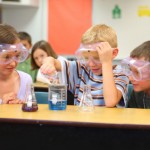
Bonus Biology Projects!
Thanks so much for joining me for the teleclass! On this page you'll find the videos for the robots that we covered in class, plus a few extras. Enjoy!
Click Here to enroll in the e-Science Curriculum AND get all the free bonuses. Start using it today!
Enroll in the e-Science curriculum starting today, and going until June of next year. Includes summer e-Camp, complete Robotics course and LOTS more! Full money-back guarantee. Click here to check it out.
Extracting DNA in Your Kitchen
If a cell has a nucleus, the DNA is located in the nucleus. If not, it is found in the cytoplasm. DNA is the genetic material that has all the information about a cell.
DNA is a long molecule found in the formed by of two strands of genes. DNA carries two copies—two “alleles”—of each gene. Those alleles can either be similar to each other (homozygous), or dissimilar (heterozygous).
We’re going to learn how to extract DNA from any fruit or vegetable you have lying around the fridge. Are you ready?
Materials:
- pumpkin OR apple OR squash OR bananas OR carrots OR anything else you might have in the fridge
- dishwashing detergent
- 91% isopropyl alcohol
- coffee filter and a funnel (or use paper towels folded into quarters)
- water
- blender
- clear glass cup
Simple Microscope & Telescope
Materials:
- window
- dollar bill
- penny
- hand-held magnifying glasses, 2
- ruler
Did you know you can create a compound microscope and a refractor telescope using the same materials? It’s all in how you use them to bend the light. These two experiments cover the fundamental basics of how two double-convex lenses can be used to make objects appear larger when right up close or farther away.
Laser Microscope
Did you know that you can use a laser to see tiny paramecia in pond water? We’re going to build a simple laser microscope that will shine through a single drop of water and project shadows on a wall or ceiling for us to study.
Materials:
- red or green laser (watch video for laser tips)
- large paperclip
- rubber band
- stack of books
- white wall
- pond water sample (or make your own from a cup of water with dead grass that’s been sitting for a week on the windowsill)
Acids and Bases
Acids are sour tasting (like a lemon), bases are bitter (like unsweetened cocoa powder). Substances in the middle are more neutral, like water. Scientists use the pH (power of hydrogen, or potential hydrogen) scale to measure how acidic or basic something is. Hydrochloric acid registers at a 1, sodium hydroxide (drain cleaner) is a 14. Water is about a 7.
The pH level will tell you how acidic or alkaline (basic) something is, like dirt. If your soil is too acidic, your plants won’t attract enough hydrogen, and too alkaline attracts too many hydrogen ions. The right balance is usually somewhere in the middle (called ‘pH neutral’). Some plants change color depending on the level of acidity in the soil – hydrangeas turn pink in acidic soil and blue in alkaline soil.
Materials:
- Litmus paper or pH paper (you can cut into strips)
- apple
- lemon
- vinegar
- baking soda
- cup with water
Click Here to enroll in the e-Science Curriculum AND get all the free bonuses. Start using it today!
Enroll in the e-Science curriculum starting today, and going until June of next year. Includes summer e-Camp, complete Robotics course and LOTS more! Full money-back guarantee. Click here to check it out.
